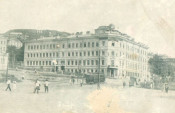
Discover Primorye with the Presidential Library
80 years ago, on October 20, 1938 Primorye Territory was formed. The new region was isolated from the Far Eastern Territory and initially included the Maritime and Ussuri regions, which were soon abolished.
Today, the population of Primorye is about two million people. The region borders on the DPRK in the south-west, China in the west, the Khabarovsk Territory in the north, and it is washed by the waters of the Sea of Japan in the south and the east.
On the Presidential Library portal three collections are devoted to the past and the present of the territory, they are: “Primorye Territory: Pages of History”, “The Russian Far East – World Economic Outpost” and “The Point of Attraction - the Russian Far East. Towards the Eastern Economic Forum”.
Let us look through the pages of history. The most valuable information about the capital of Primorye is reflected in the publication "Entire business and trade Vladivostok in 1924". "The moment of the city's appearance is attributed to the feat of the warrant officer Komarov, who with a team of 40 lower ranks on June 20, 1860 occupied the territory of modern Vladivostok", - the book says.
Herewith, day of foundation of the city, June 20, 1860, is called rather tentative, since “back in 1858, when signing the Aigun Treaty between Russia and China, Russia’s rights to the territory of modern Vladivostok were mentioned”, “in 1851 German and French sources indicated the presence of Russian in the area of Peter the Great Bay, and the newspaper St. Petersburg Vedomosti reported on a visit to the Golden Horn Bay by the warship Manjour in 1852.
In other words, the resettlement of Russians to these places began earlier than the formal dates on the laying of military posts.
The difficulty of getting to Primorye Territory from the European part of Russia is described in the book From Petrograd to Vladivostok (1915): “The shortest path from Petrograd to Vladivostok is 8154 versts. Passengers travel this distance in 9-12 days”.
The railway station was built in Vladivostok only in 1893 (by the way, the crown prince, the future emperor Nicholas II laid it down). The publication “Entire business and trade Vladivostok in 1924” states that when settling the Far Eastern territories in the middle of the XIX century “from Chita to Blagoveshchensk it took at least two years for future cultural traders (culture carriers), and a further journey to Primorye took up ten more years old".
One of the first researchers of the Primorye Territory, R. K. Maak, in his book of 1861 “Journey through the Ussuri River Valley” wrote that he set off from St. Petersburg on February 16, and arrived at his destination in Primorye only in early June, having overcome almost 9000 miles for three and a half month.
Immense distances that people had to overcome in the Far East are illustrated by I. P. Nadarov’s book “Materials for the Study of the Ussuri Region” of 1886: “In 1868, the designated immigrants were transferred to the authorized immigrants in the area of Vladivostok, including the Russky Island, on which it was supposed to settle immigrants from Finland, who arrived by sea in 1869". That is, during the times of the Russian Empire, travels from the extreme north-west to the extreme southeast of a huge country were accomplished!
Meanwhile, Vladivostok, founded in 1860, grew by leaps and bounds, which is again evidenced by the book of I. P. Nadarov. By its 25th anniversary, a small military post turned into a full-fledged city and stronghold of Russia in the Pacific region: “In 1862, Vladivostok was referred to a port. On December 25, 1862, duty-free trade in foreign goods was allowed in the port. In 1864 in Vladivostok a public administration headed by a public leader was emerged. In 1865, the first ship, the Suifun boat, was built in the city for the Siberian flotilla. In 1873, the main Russian port in the Great Ocean was transferred from Nikolaevsk to Vladivostok.
In 1886, steamboats of the Voluntary Fleet began regular voyages between Vladivostok, Kamchatka and Sakhalin. “Until the beginning of the eighties, the aforementioned messages were maintained exclusively by occasional foreign steamers”, - noted N. P. Zabugin in this connection in the book On Shipping in the Russian Far East in 1896.
During the Russo-Japanese War of 1904-1905, Vladivostok was filled with mobilized spare parts from all over Russia.
During the years of revolution and the Civil War, Primorye underwent regular changes.
But already in the 20s, according to the testimony of the collection “Entire business and trade Vladivostok in 1924”, “from all the cities of the Far East and Siberia, Vladivostok in its present form looked undoubtedly the most comfortable”.
The collection of the Presidential Library "The Russian Far East – World Economic Outpost" includes documents on economics, as well as a description of international transport corridors and a variety of cartographic, graphic, and video materials.
The comprehensive collection “The Point of Attraction - the Russian Far East” was released opening the Eastern Economic Forum - one of the largest and most important events in the business life of the Pacific region and Russia.









